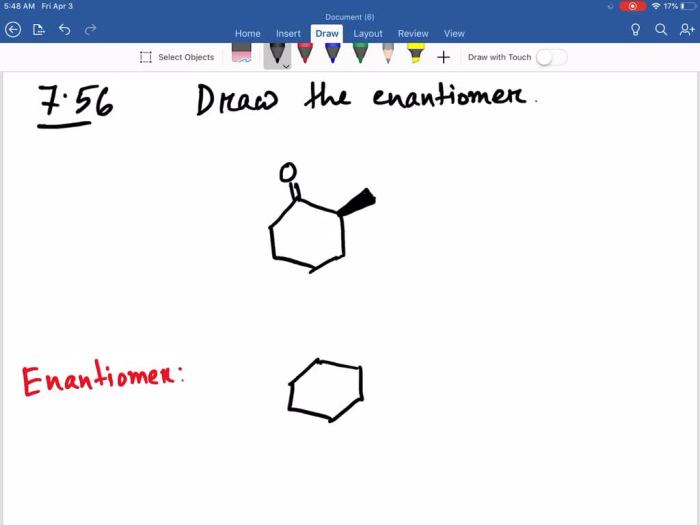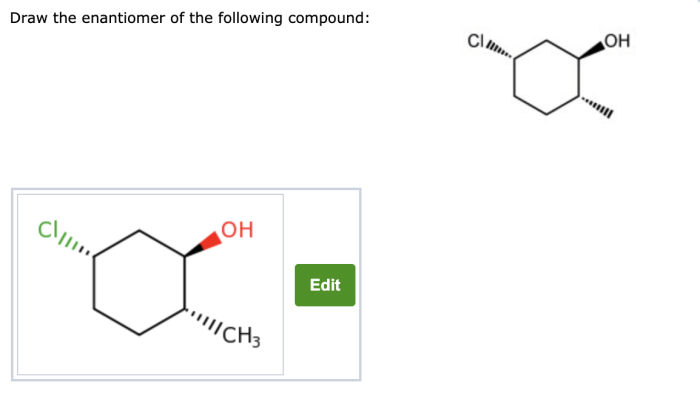Draw the enantiomer of the following compound – Delving into the realm of stereochemistry, we embark on a journey to explore the fascinating concept of enantiomers. This article, “Draw the Enantiomer: A Step-by-Step Guide,” unravels the intricacies of enantiomers, guiding you through the process of drawing their mirror-image counterparts with precision.
Enantiomers, molecules with identical molecular formulas but non-superimposable mirror-image structures, play a pivotal role in various scientific disciplines. Understanding their properties and applications is crucial for advancing our knowledge in fields such as pharmaceuticals, materials science, and beyond.
1. Draw the Enantiomer of a Given Compound

Enantiomers are stereoisomers that are non-superimposable mirror images of each other. They have the same molecular formula and connectivity but differ in the spatial arrangement of their atoms.
To draw the enantiomer of a given compound, follow these steps:
- Identify the chiral center(s) in the molecule. A chiral center is a carbon atom that is bonded to four different groups.
- Invert the configuration of the chiral center(s). This means that if the original compound has an R configuration, the enantiomer will have an S configuration, and vice versa.
- Draw the mirror image of the original compound.
2. Examples of Enantiomers

Here are some examples of enantiomers:
| Compound | Structure |
|---|---|
| Alanine |  |
| Lactic acid |  |
| Ibuprofen |  |
Enantiomers can be identified using various methods, such as:
- Optical activity: Enantiomers rotate plane-polarized light in opposite directions.
- Chiral chromatography: Enantiomers can be separated using chiral stationary phases.
- NMR spectroscopy: Enantiomers have different NMR spectra.
3. Properties and Applications of Enantiomers

Enantiomers often have different physical and chemical properties. For example, they may have different melting points, boiling points, and solubilities.
Enantiomers are used in a variety of applications, including:
- Pharmaceuticals: Enantiomers can have different biological activities. For example, one enantiomer of a drug may be active while the other enantiomer is inactive or even harmful.
- Materials science: Enantiomers can be used to create materials with specific properties. For example, chiral polymers can be used to create materials with unique optical properties.
4. Advanced Topics in Enantiomer Analysis

There are a number of advanced techniques that can be used to analyze enantiomers. These techniques include:
- Chiral chromatography: Chiral chromatography is a technique that can be used to separate enantiomers. Chiral chromatography columns are packed with a chiral stationary phase that interacts differently with the two enantiomers.
- Spectroscopy: Spectroscopy can be used to identify and characterize enantiomers. For example, NMR spectroscopy can be used to determine the absolute configuration of a chiral center.
The analysis of enantiomers is a challenging but important task. Enantiomers can have different biological and chemical properties, so it is important to be able to identify and characterize them.
FAQ Overview: Draw The Enantiomer Of The Following Compound
What is the difference between an enantiomer and a diastereomer?
Enantiomers are non-superimposable mirror images of each other, while diastereomers are stereoisomers that are not mirror images.
How can I identify chiral centers in a molecule?
A chiral center is a carbon atom bonded to four different groups. Identifying chiral centers is crucial for determining the presence of enantiomers.
What are the applications of enantiomers in the pharmaceutical industry?
Enantiomers often exhibit different biological activities, making them valuable in drug development. One enantiomer may be therapeutic, while the other may be inactive or even harmful.